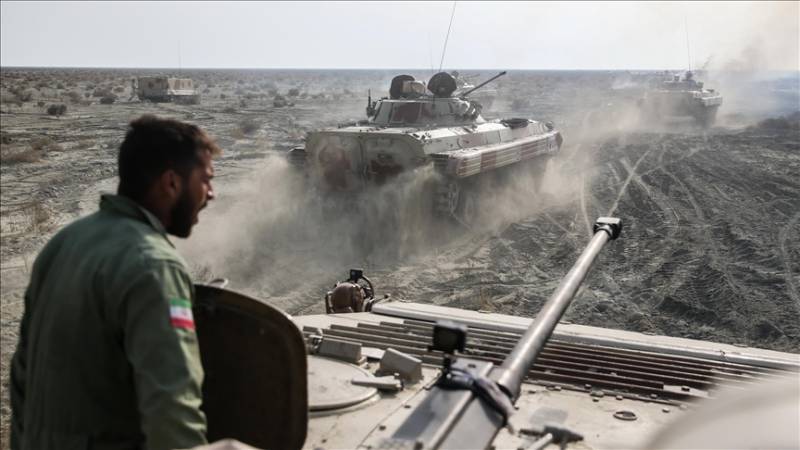Iran has held a series of military drills in recent weeks, involving homegrown missiles, drones, helicopters, submarines, military ships, and UAVs.
The exercises have gained momentum since the US dispatched warships, submarines and an aircraft carrier to the Gulf region, sparking tensions and fears of a direct military confrontation between Tehran and Washington.
On Wednesday, the Iranian army’s ground forces wrapped up a two-day military exercise code-named “Eqtedar-99” along the country’s Makran coast in the Sea of Oman in the presence of top military officials.
In the drill, Special Forces’ Brigade 65 staged air, offensive and penetration operations in which army’s divers landed on the water surface and Chinook helicopters penetrated deep into the sea.
The army’s deputy commander, Brig. Gen. Kiomars Sharafi, said “disrupting the enemy’s command and communication system at the sea” were among tactics performed during the drill.
In the first phase of the exercise on Tuesday, the ground forces launched large-scale “offensive operations” along the southeastern coast, including parachuting operations by airborne forces.
The Shiraz Airborne Brigade riding C-130 military aircraft landed at points designated for them with military equipment, including motorcycles and rocket launchers, Brig. Gen. Sharafi said.
Last week, the elite IRGC’s aerospace division held a large-scale military exercise code-named “Great Prophet 15”, which involved new-generation ballistic missiles and bomber drones in the country’s central desert. A wide array of long-range ballistic missiles and drones were used to target “hypothetical enemy bases” in the Sea of Oman and the northern parts of the Indian Ocean during the military games.
Ground-to-ground ballistic missiles with a range of 1,800 km, which officials claim are "able to break through the enemy's defense systems", were introduced during the drill.
Iran’s army chief Gen. Mohammad Hossein Bagheri, who was present at the occasion, said Iran was “at the peak of its power” with “high preparedness in land, air, sea and missile defense”.
IRGC chief Gen. Hossein Salami said the ongoing military exercises were aimed at showing Iran’s “deterrent power” and to “thwart hostile moves of the enemy”, referring to the US.
He added that the “use of new technologies” had given a boost to new-generation Iranian missiles, which are “able to hit all the targets accurately”.
The “Great Prophet 15” drill, which is held annually since 2008 by the IRGC, came this year amid heightened tensions between Iran and the US.
Last week, Iran’s Navy carried out a major exercise in the Gulf of Oman, in which the forward base ship Makran and a missile-launching frigate Zereh were formally handed over to the naval forces.
Makran, previously an oil tanker, has been called the “biggest logistics vessel in the Middle East” with a length of 755 feet, capable of carrying six to seven helicopters.
Zereh missile-launching warship, known for its maneuverability and speed, has been hailed as one of Iran's powerful vessels equipped with advanced missiles and artillery.
The IRGC also held a naval parade in the Persian Gulf two weeks ago in which around 700 vessels were exhibited. The occasion marked five years since the seizure of US Navy command boats in the area.
On Jan. 12, 2016, IRGC’s naval forces had seized two US Navy riverine command boats near Farsi Island after they had allegedly crossed into Iran’s territorial waters. They were set free within 24 hours.
The naval parade also came a week after the IRGC seized a South Korean-flagged vessel in the Persian Gulf over alleged “maritime environmental pollution”. The two sides continue to negotiate its release.
The large parade concluded with the unveiling of an underground anti-ship missile base along the shores of the Persian Gulf in Hormozgan province by IRGC chief Gen. Salami.
The missiles at the base, he said, have a range of hundreds of kilometers and are able to “deceive the defensive systems of enemies”, obliquely referring to US bases in the region.
The ongoing war games coincide with simmering tensions between Iran and the US at the time of political transition in Washington.
Iran's Foreign Ministry earlier this month said it was “monitoring” what it termed “hidden moves” by the US in the region and said it had conveyed “warnings” to Washington and regional countries.
It came after the Pentagon reversed its previous decision and ordered aircraft carrier Nimitz to remain in the Persian Gulf region in view of what it termed “threats issued by Iranian leaders against President Trump and other US officials”.
The strategic B-52H US bombers have also made multiple appearances in the region in recent months, twice this month.
The US Central Command said in a statement on Sunday said the "bomber task force missions" had done a “presence patrol” in the Middle East, which he said is “important part of our defensive posture in the region.”
In response, Iran's Foreign Minister Javad Zarif vowed a strong retaliation. “If your B-52H Presence Patrols are meant to intimidate or warn Iran, you should have spent those $billions on your taxpayers' health,” he tweeted.
With Joe Biden taking over as the new US President Wednesday, all eyes would be on how the tensions between the two long-time adversaries will pan out in coming weeks and months.






